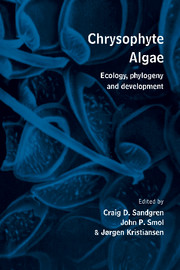Book contents
- Frontmatter
- Contents
- Preface
- List of contributors
- 1 History of chrysophyte research: origin and development of concepts and ideas
- Part I Phylogeny, systematics and evolution
- Part II Development, physiology and nutrition
- Part III Ecology, paleoecology and reproduction
- Part IV Contributed original papers
- 14 Mallomonas variabilis, sp. nov. (Synurophyceae) with stomatocysts found in Lake Konnevesi, Finland
- 15 Scale morphology and growth characteristics of clones of Synura petersenii (Synurophyceae) at different temperatures
- 16 Status of the Chrysamoebales (Chrysophyceae): observations on Chrysamoeba pyrenoidifera, Rhizochromulina marina and Lagynion delicatulum
- 17 The genus Paraphysomonas from Indian rivers, lakes, ponds and tanks
- Index of scientific names
- Subject index
17 - The genus Paraphysomonas from Indian rivers, lakes, ponds and tanks
Published online by Cambridge University Press: 05 March 2012
- Frontmatter
- Contents
- Preface
- List of contributors
- 1 History of chrysophyte research: origin and development of concepts and ideas
- Part I Phylogeny, systematics and evolution
- Part II Development, physiology and nutrition
- Part III Ecology, paleoecology and reproduction
- Part IV Contributed original papers
- 14 Mallomonas variabilis, sp. nov. (Synurophyceae) with stomatocysts found in Lake Konnevesi, Finland
- 15 Scale morphology and growth characteristics of clones of Synura petersenii (Synurophyceae) at different temperatures
- 16 Status of the Chrysamoebales (Chrysophyceae): observations on Chrysamoeba pyrenoidifera, Rhizochromulina marina and Lagynion delicatulum
- 17 The genus Paraphysomonas from Indian rivers, lakes, ponds and tanks
- Index of scientific names
- Subject index
Summary
Introduction
The colorless chrysophyte genus Paraphysomonas de Saedeleer includes about 50 taxa. All have typical heterokont flagellation and silicified scales covering the cell body. Only a very few of the larger spine-scales are visible in the light microscope. Electron microscopy is necessary for the identification of most species and subspecies.
Examinations of the freshwater algal flora of the tropics are numerous, and in recent years have started to include the chrysophytes. Cronberg (1989) has summarized all of the literature on scaled chrysophytes from the tropics. However, there has been only one study using electron microscopy from India and two from countries adjacent to India: Bangladesh (Takahashi & Hayakawa 1979) and Sri Lanka (Dürrschmidt & Cronberg 1989).
During a study of the biota of silica-scaled protists in Indian freshwaters, a number of species not previously reported were observed (Saha & Wujek 1990). This paper focusses not only on Paraphysomonas species not previously recorded, adding to the knowledge of their occurrence and distribution, but also presents descriptions of two new species.
Materials and methods
The sites that contained Paraphysomonas taxa are listed in Table 17.1 Sample fixation and preparation were as described in Saha & Wujek (1990); or the specimens were shadowed with platinum/palladium.
- Type
- Chapter
- Information
- Chrysophyte AlgaeEcology, Phylogeny and Development, pp. 373 - 384Publisher: Cambridge University PressPrint publication year: 1995

